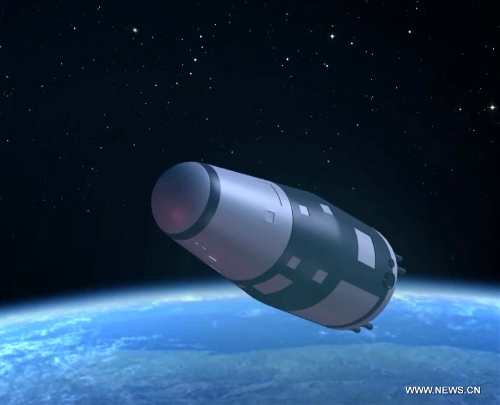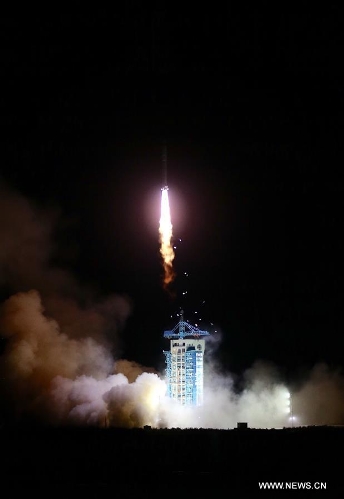China launches retrievable space science probe

The simulation photo provided by the Chinese Academy of Sciences, shows the SJ-10 Satellite working in space. China put into space a retrievable scientific research satellite SJ-10 in the early hours of Wednesday in a fresh bid to aid scientists back on Earth in studying microgravity and space life science. (Xinhua/Chinese Academy of Sciences)
China sent a retrievable scientific research satellite into space in the early hours of Wednesday to aid scientists back on Earth in studying microgravity and space life sciences.
In a cloud of brown smoke, the satellite, SJ-10, roared into the air on the back of a Long March 2-D rocket from Jiuquan Satellite Launch Center in northwest China's Gobi Desert at 1:38 a.m. Beijing time.
As part of a growing program of space science research, the SJ-10 project is jointly developed by 11 institutes of the Chinese Academy of Sciences (CAS) and six Chinese universities in cooperation with the European Space Agency (ESA) and Japan Aerospace Exploration Agency.
The bullet-shaped probe, with a designed life of 15 days, is composed of an orbital module and a re-entry capsule, together housing 19 experiments involving microgravity fluid physics, microgravity combustion, space material, space radiation effects, microgravity biological effects and space bio-technology.
These experiments include one on early-stage development of mouse embryos in microgravity to shed light on human reproduction in space, and another studying how space radiation affects the genetic stability of fruit flies and rat cells.
An experiment being run in partnership between the National Space Science Center under the CAS and the ESA will investigate the behavior of crude oil under high pressure, and also on board is equipment to test coal combustion and pollutant formation under microgravity. The former experiment is aimed at improving scientists' understanding of oil reservoirs buried deep underground, while the latter is expected to help enhance energy efficiency and cut emissions on Earth.
Another combustion experiment will test how materials used in spacecraft burn in space to find ways of making safer capsules for future manned missions.
"All the experiments to be conducted on SJ-10 have never been done before either at home or abroad," said Hu Wenrui, chief scientist of the mission. "They could lead to key breakthroughs in academic research."
SJ-10 is the second of four scientific satellites under a CAS space program. Unlike the other three, SJ-10 is returnable. It is the 25th such retrievable satellite launched by China.
Eight of the 19 experiments will be carried out in the orbital module and the others in the re-entry capsule, which is expected to land after its brief mission in Siziwang Banner in Inner Mongolia, the designated landing spot for China's Shenzhou manned space missions and a 2014 test lunar orbiter. All of China's previous 24 recoverable satellites were recovered in the southwestern province of Sichuan.
NEW ERA
The launch of SJ-10 came more than three months after the take-off of China's first Dark Matter Particle Explorer (DAMPE) Satellite, which blasted off in December to shine light on the invisible material that scientists say makes up most of the universe's mass.
Two more new scientific satellites, one for quantum science experiments and the other a powerful X-ray telescope to observe black holes, neutron stars and other phenomena, will be launched later this year under the CAS program.
Together, the series of space science probes could mark a new step in China's multi-billion-dollar space missions, a great source of national pride and a marker of China's global stature and technical expertise.
The country sent its first astronaut into space in 2003, becoming the third nation after Russia and the United States to achieve manned space travel independently. In 2008, astronauts aboard Shenzhou-7 made China's first space walk. There are also plans for a space station to be completed around 2020.
But so far, China's space endeavors have focused more on human and robotic exploration, with investment in space science comparatively limited.
China's first satellite was launched into space 46 years ago, and a number of communication, remote sensing and navigation satellites have followed. Yet the country has very few satellites solely designed for scientific research.
Hopefully, the CAS program will make a difference.
"China is already a major player in space. To seek further progress in the field, however, we have to launch more space science satellites," said Wu Ji, director of the National Space Science Center.
Wu said that space science was important to the technological modernization and "innovation" being encouraged by the government. "If you want to innovate, you must understand science."
"In space science, China is still a user of knowledge at the moment, but we should also strive to be the creator," he added.

A Long March 2-D rocket carrying the SJ-10 Satellite blasts off at the Jiuquan Satellite Launch Center in Jiuquan, northwest China's Gansu Province, April 6, 2016. China put into space a retrievable scientific research satellite in the early hours of Wednesday in a fresh bid to aid scientists back on Earth in studying microgravity and space life science. (Xinhua/Jin Liwang)

A Long March 2-D rocket carrying the SJ-10 Satellite blasts off at the Jiuquan Satellite Launch Center in Jiuquan, northwest China's Gansu Province, April 6, 2016. China put into space a retrievable scientific research satellite in the early hours of Wednesday in a fresh bid to aid scientists back on Earth in studying microgravity and space life science. (Xinhua/Jin Liwang)

A Long March 2-D rocket carrying the SJ-10 Satellite blasts off at the Jiuquan Satellite Launch Center in Jiuquan, northwest China's Gansu Province, April 6, 2016. China put into space a retrievable scientific research satellite in the early hours of Wednesday in a fresh bid to aid scientists back on Earth in studying microgravity and space life science. (Xinhua/Jin Liwang)


Photo provided by the Chinese Academy of Sciences, taken on Sept. 8, 2015 shows the SJ-10 Satellite under experiment. China put into space a retrievable scientific research satellite SJ-10 in the early hours of Wednesday in a fresh bid to aid scientists back on Earth in studying microgravity and space life science. (Xinhua/Chinese Academy of Sciences)

Photo provided by the Chinese Academy of Sciences, taken on Sept. 8, 2015 shows the SJ-10 Satellite under experiment. China put into space a retrievable scientific research satellite SJ-10 in the early hours of Wednesday in a fresh bid to aid scientists back on Earth in studying microgravity and space life science. (Xinhua/Chinese Academy of Sciences)